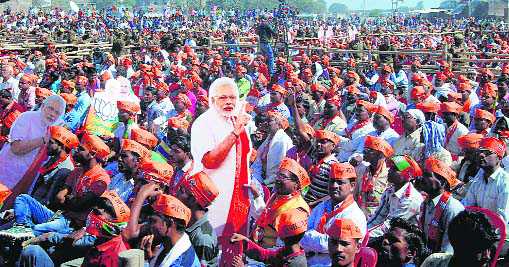
Influencing voters: Modi cutouts at a rally. PTI
Vikas Singh
Political marketeer
Poltical marketing is a well-established subject in western countries, but it is practised without much theoretical backing in India. Voters are treated as a consumer, their needs are identified and researched upon; and based on this, advertising campaigns are designed, and political promises andleaders sold as a product in return for vote.
Historically, politicians have strived to understand the perception of voters and accordingly prepared their communication strategy. This awareness of a voter is influenced by her learning, experiences, and political socialisation. Campbell, in his book, 'The American Voter'’, argued how informal sources like family, friends and peers influence the political behaviour of a voter. However, this trend is fast changing. Formal sources like television, Internet and newspaper, have taken over. In response, the practices adopted by political parties to influence voters are also changing.
Influencing economic & political choices
In this background, let us see the case of 'Cambridge Analytica', which allegedly breached the privacy of users and analysed the perceptual trends from Facebook. It is also alleged that they designed political communication strategies based on these trends for their clients to influence the voters' choice. Such practices are used to influence the economic choice of consumers. The practice is popularly termed as digital marketing. Now, for the first time, political choice is allegedly influenced in this way. The question is whether while it is acceptable to influence one's economic choice by marketing but not the political one.
In the race to win the mindshare of voters, political marketing agencies focus on 360-degree communication for the candidates. It can be categorised in three verticals:
- Content development: It includes manifesto development, slogans, speeches and interviews to be delivered by leaders and audio-visual bytes broadcast through mainstream and social media.
- Medium: The medium through which the content is disseminated, including television, radio, newspaper, social media, loudspeakers, accessories like caps, badges and outdoor advertising, such as banners, posters, pamphlets and hoardings. Efforts are directed towards repetition of catchy content through all mediums to stay at the top-of-mind-recall of the voters.
- Event: It enables on-ground symbolic activity to show strength through public meetings (rallies), resentment through protests, connectivity through roadshows, inclusiveness through religious visits and dinner programmes. Ormord et al. have given the example of Gandhi burning English clothes as one of the important symbolic events with a far-reaching impact in India's independence struggle. 'Chai-pe-Charcha' and 'Khat-Sabha' are two recent examples of political events interestingly executed by the same agency but for different parties. The first successfully established the humble background of Narendra Modi, the second failed to create a farmer-friendly image of Rahul Gandhi.
Idol versus ideology
The leader remains at the centre of political marketing. The ideologies are withering and elections are becoming more idol-centric and the leader’s persona is taking over party policies. Elections around the world are following in the footsteps of the US presidential-type campaigns, where the face of a party is the most important tool.
Thus, the primary task of a political marketing agency is to craft the image of a leader, who acts as the brand ambassador of the party, policy, government and the people at large. In a democratic set-up, if a voter is convinced of similarities between the leader and himself, pulling votes is not tough; the 'chaiwala-Modi' and 'Gaiwala-Lalu' are used to brand them as representatives of the poor and Yadavs, respectively. A larger-than-life persona of Modi crafted during the branding of Gujarat in the 2012 Assembly elections gradually focused on a powerful leader with a humble background and strong decision-making ability.
The Congress tried to project Rahul Gandhi as an alternative with a statesman-like charm, which has seen some light only recently. Clever strategies seek to malign competitors by exposing their weakness in front of voters, who consume it with a pinch of salt. This led to a war on social media, where fake videos were used to denounce credibility of competing leaders. Videos to project Rahul Gandhi as 'Pappu' made out of mixing of two or three unrelated speeches are made viral by BJP supporting groups, even as Congress groups are campaigning to project Modi as 'Feku' by using his photos against unfulfilled promises.
The future
A whopping $5 billion (highest in the world) was spent by various political parties on political marketing in the 2014 elections in India. Some private companies provide support to the parties, not explicitly in the name of marketing though. They include the Indian Political Action Committee (IPAC), the Association of Brilliant Minds (ABM) working for the BJP, Dentsu worked with the Congress and APCO-managed brand Modi in 2014. Besides, many others are subcontracted at local levels. The dubious source of funding is one of the many reasons why politicians and companies avoid talking about this open secret. This field will see the entry of more companies, given the quantum of money involved; and as the sector grows, so will awareness of voters about the subject.
The citizens will start to understand the efforts adopted by political parties and leaders to influence the voting behaviour through marketing tools. Like in the case of consumer goods, marketing agencies will assist parties in understanding the needs of voters and design campaigns accordingly. Eventually, it may lead to developing a feedback loop which becomes a tool for participative democracy, where voters can communicate their priorities to politicians and policymakers. With the upcoming polls in three big states and the General Election close by, you may observe a subconscious inclination towards a leader, and it may be a result of efforts made by his agency of political marketing.



























